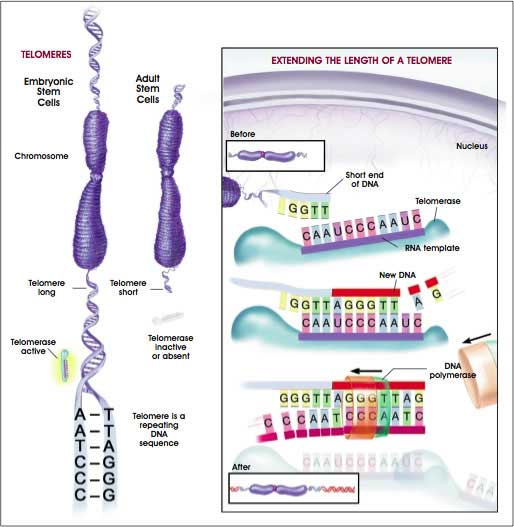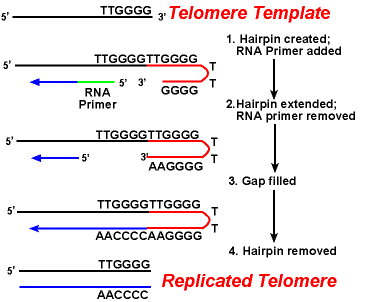


Telomere maintenance and cancer ? look, no telomerase

more and more...




Telomerase
DEFINITION
Telomerase is an enzyme that adds DNA sequence repeats ("TTAGGG" in all vertebrates) to the 3' end of DNA strands in the telomere regions, which are found at the ends of eukaryotic chromosomes. This region of repeated nucleotide called telomeres contains non-coding DNA material and prevents constant loss of important DNA from chromosome ends. As a result, every time the chromosome is copied only 100-200 nucleotides are lost, which causes no damage to the organism's DNA. Telomerase is a reverse transcriptase that carries its own RNA molecule, which is used as a template when it elongates telomeres, which are shortened after each replication cycle.
THE GENE
Wikigenes includes links to
- NCBI Gene
- NCBI SNP
- iHOP resource
- OMIM
- SNPedia
- UniProt
- Ensembl
- HGNC
CHEMICAL STRUCTURE AND IMAGES
When relevant for the function
- Primary structure
- Secondary structure
- Tertiary structure
- Quaternary structure
Protein Aminoacids Percentage


TERC (RNA) Bases Percentage

The increased ratio G/A anf C/T correspond to a hypoxic environment (increased glutamine/glutamate) when the TERC RNA (NR_001566) is synthesized from the corresponding gene (NG_016363)
SYNTHESIS AND TURNOVER
mRNA synthesis
protein synthesis
post-translational modifications
degradation
CELLULAR FUNCTIONS
cellular localization,
biological function
Dyskerin


Impaired control of IRES-mediated translation in X-linked dyskeratosis congenita., 2006
The DKC1 gene encodes a pseudouridine synthase that modifies ribosomal RNA (rRNA) . DKC1 is mutated in people with X-linked dyskeratosis congenita (X-DC), a disease characterized by bone marrow failure, skin abnormalities, and increased susceptibility to cancer. How alterations in ribosome modification might lead to cancer and other features of the disease remains unknown. Using an unbiased proteomics strategy, we discovered a specific defect in IRES (internal ribosome entry site)-dependent translation in Dkc1 mice and in cells from X-DC patients. This defect results in impaired translation of messenger RNAs containing IRES elements, including those encoding the tumor suppressor p27(Kip1) and the antiapoptotic factors Bcl-xL and XIAP (X-linked Inhibitor of Apoptosis Protein). Moreover, Dkc1 ribosomes were unable to direct translation from IRES elements present in viral messenger RNAs. These findings reveal a potential mechanism by which defective ribosome activity leads to disease and cancer.
- Cell signaling and Ligand transport
- Structural proteins
REGULATION
DIAGNOSTIC USE
Telomeres Affect Gene Expression 2013